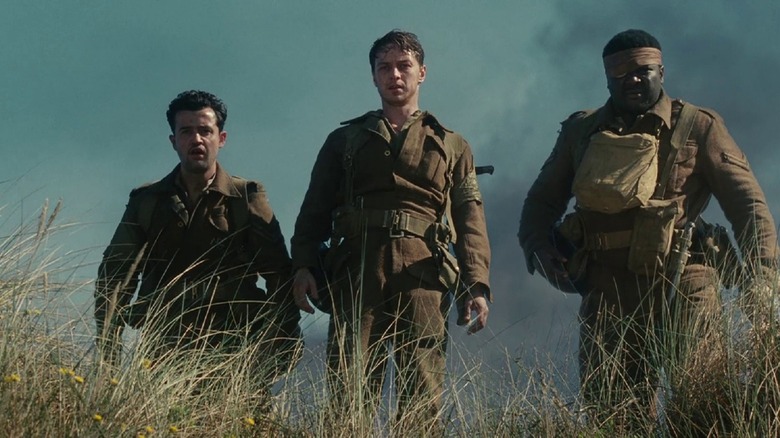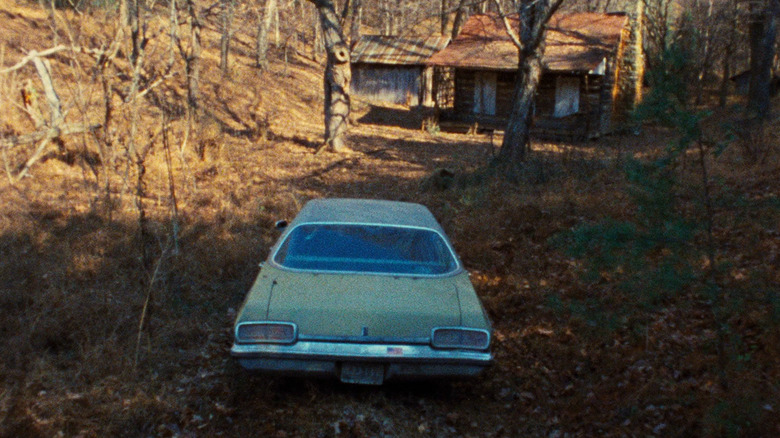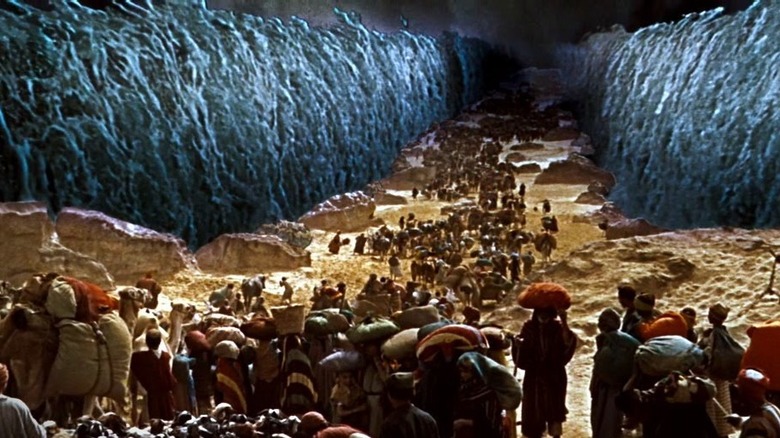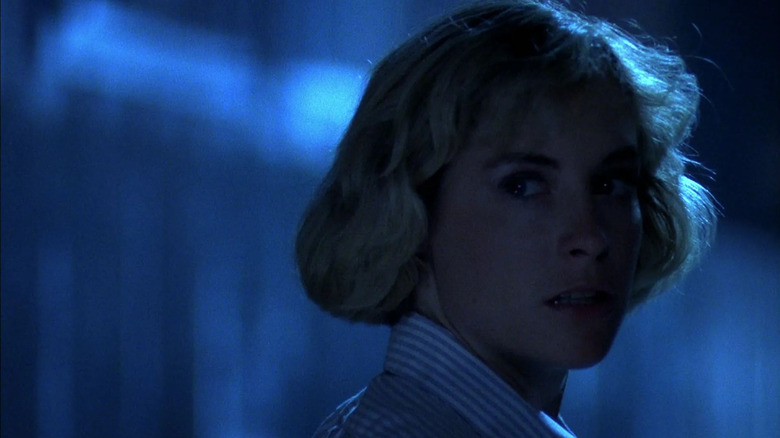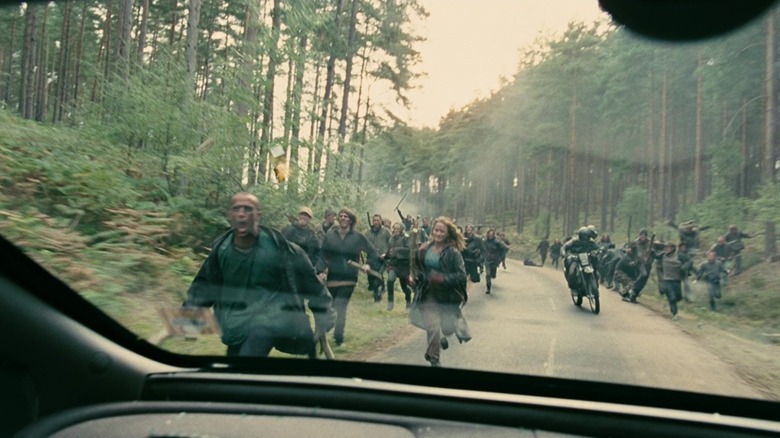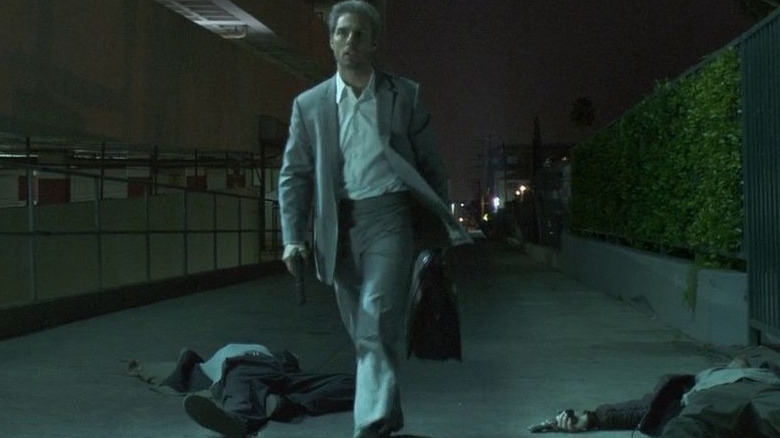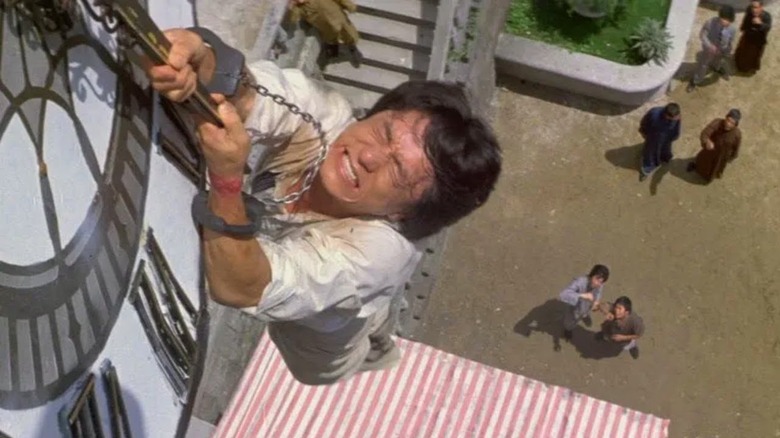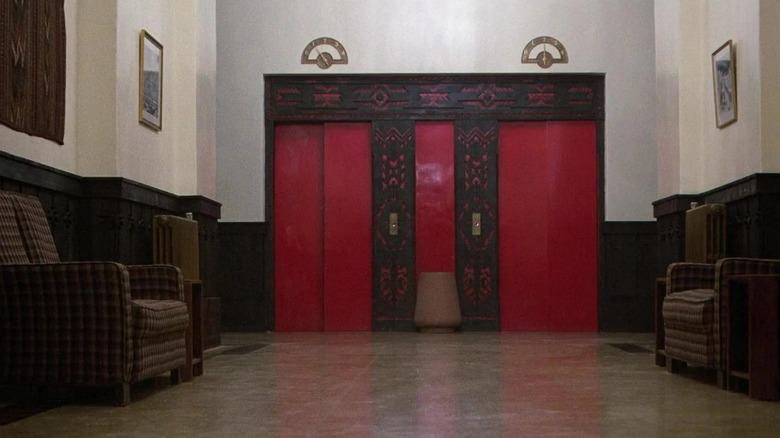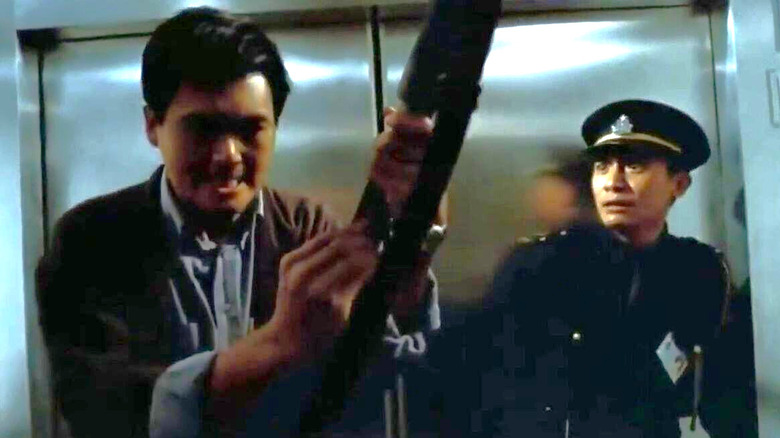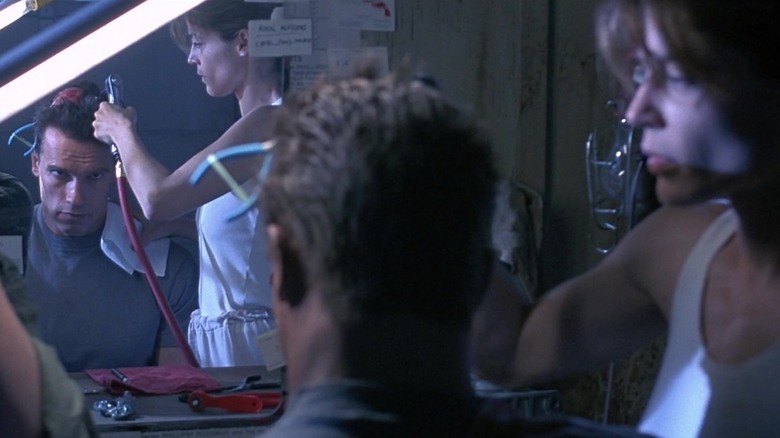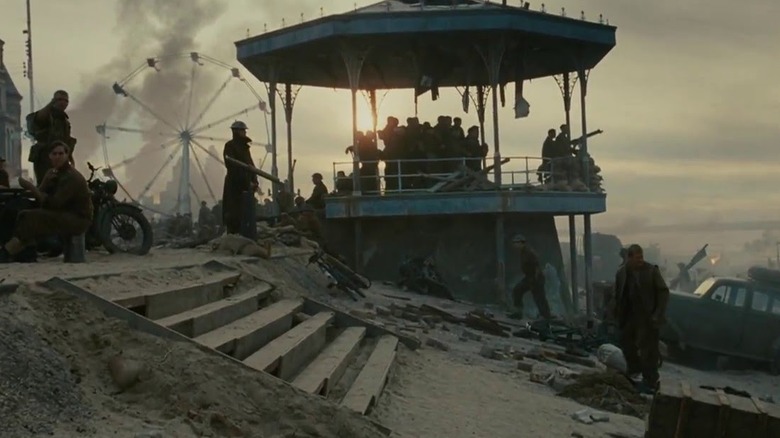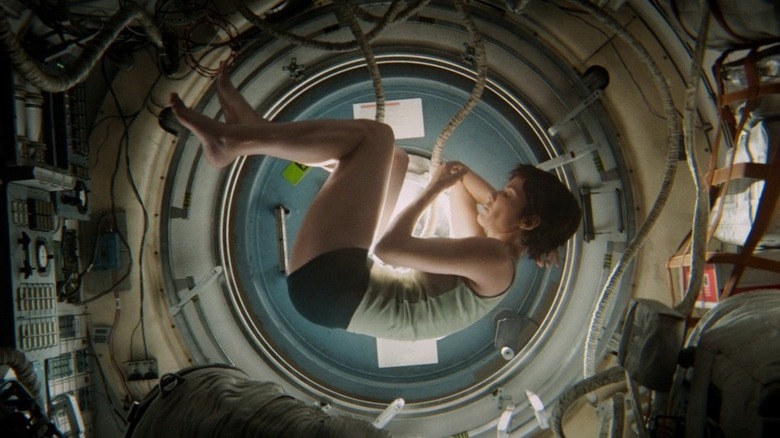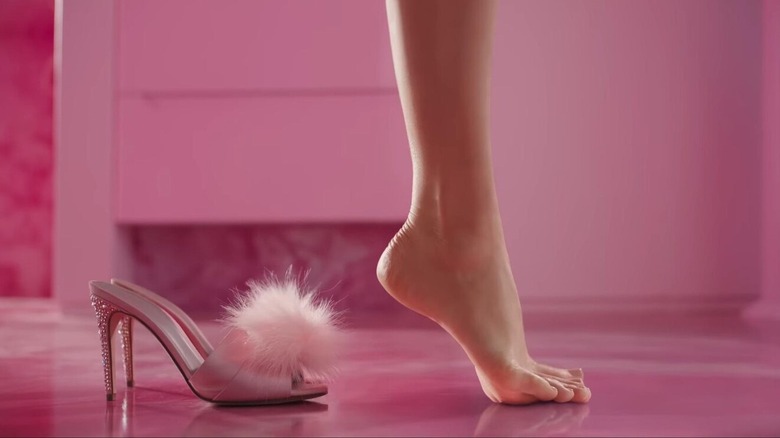12 Famous Movie Shots And How They Pulled Them Off
Shots are the building blocks that make up all of cinema. While plenty of shots are functional and contribute to the overall work, some stick in our memory as lasting images. Individual shots might stand out due to their beauty, their raw emotional resonance, or perhaps because of their mind-boggling nature. Plenty of these shots will leave you scratching your head and wondering how the heck the filmmakers did that.
Whether through practical or digital special effects or through raw ingenuity and cleverness behind the camera, filmmakers constantly find unique and creative ways to execute seemingly impossible feats. Even before computers or without large budgets to pull from, resourceful creatives have proven time and time again that the only real limit in the world of cinema is your imagination. Let's take a trip behind the scenes and break down how some of the most famous movie shots were pulled off.
The Evil Dead demon POV
1981's "The Evil Dead" is one of the biggest low-budget success stories of the horror genre. The budget simply wasn't large enough to pull off the special effects that writer and director Sam Raimi had in mind, and the shoot required extreme ingenuity to avoid disaster. One of the film's most striking visuals is a POV shot of a flying demon traveling through the forest at great speed, past and through various obstacles.
Without the money to rent a dolly, a Steadicam — a relatively new invention at the time — or any other professional camera rigging, Raimi settled on the simple yet brilliant solution of bolting the camera onto a long plank of wood and having two people run with it while holding opposite ends. This gave the POV shot its perfectly off-kilter movement. At other points, the same effect was pulled off in a number of ways, including strapping the camera to a dirt bike, taping the camera directly to Raimi's hands, having star Bruce Campbell push Raimi through murky water in a tiny raft, and sliding the camera along a Vaseline-covered plank.
Parting the red sea in The Ten Commandments
The special effects from old Hollywood films — despite being cutting edge in their day — often don't hold up to modern scrutiny. Shots that were considered jaw-dropping run the risk of looking corny and antiquated in retrospect. One major exception can be found in the 1956 film "The Ten Commandments." The sequence where Moses (Charlton Heston) parts the Red Sea does look dated but how they did it remains incredibly impressive to this day.
This ambitious special effects sequence was a massive undertaking and contributed to "The Ten Commandments" becoming the most expensive film ever made at the time. A wide array of tactics and techniques were employed and blended together in order to pull off the impressive technique. Gigantic water tanks were custom-built on the Paramount Pictures backlot that allowed large amounts of water to flow naturally in the correct path and shape needed for the shot. The camera recorded the asset from a canted angle so that the water appeared to move upwards, and that recording was then composited into the scene.
In a different tank on the backlot, a deep trench was flooded with water from both sides while the camera filmed it head-on. This footage was then reversed and composited between the walls of water to complete the illusion of the Red Sea parting.
Blood on the ceiling in A Nightmare on Elm Street
The first death scene in "A Nightmare on Elm Street" remains one of the franchise's most memorable kills. After showcasing the dream world for the first time as Freddy Krueger (Robert Englund) torments Tina (Amanda Wyss) with his supernatural powers, the film jumps back to the real world to show what her death looked like from the outside.
The moment that Tina rises into the air right in front of her stunned boyfriend Rod (Jsu Garcia) was achieved by lifting her on wires. However, the main shot that showcases her drawn-out death on the wall and ceiling couldn't be done with wires and demanded more creativity. The bedroom set was built inside of a giant metal frame that was designed to rotate 360 degrees. The props and set dressing were all secured in place so that the effects of gravity wouldn't give away the illusion. The camera was mounted upside down and locked in place so that its perspective wouldn't change as the entire set rotated and Wyss scrambled along the wall and ceiling.
To sell the effect even more, they included Garcia in the foreground of the shot, looking up at Wyss. In reality, Garcia was the one strapped in upside down right beside the camera. The same rotating set was used for Glen's (Johnny Depp) death scene where blood shoots from his bed and splashes across the ceiling.
The Children of Men car sequence
Alfonso Cuarón's "Children of Men" is famous for its extremely long takes that last for several minutes at a time and involve incredibly complex choreography and coordination. There are multiple impressive long takes in the film, but the most technically complicated is the car ambush sequence, that lasts for about four-and-a-half minutes and is packed with action. A small amount of VFX was used for things like the digital displays on the car's windshield, but the vast majority of this extremely complicated shot was pulled off for real.
A custom rig was built on top of and on all sides of the car. A stunt driver positioned out of sight on the front of the vehicle did the steering while the camera was remote-controlled and had full 360º range of movement within the car. As the camera glided around the tight confines of the car, the actors were required to lean and recline out of its path and get back into position at carefully timed moments. All of the action happening outside of the vehicle was pulled off simultaneously, from the flaming car that blocks the road to the dozens of extras that form an angry mob. After extensive planning and a great deal of time spent in rehearsals, they nailed this complex single-take for the film.
The Collateral briefcase shootout
A major part of the success of Michael Mann's "Collateral" is owed to the lethal efficiency of Tom Cruise's physical performance as the villainous Vincent. Nowhere is his deadly expertise more apparent than in the quick one-take shootout that follows Vincent as he retrieves his stolen briefcase from two thugs.
In order for Cruise to fully embody the role and pull off this shot along with the rest of the action in the film, Mann put him through an extensive training program using real guns and ammunition. The full program lasted for months and repeatedly put Cruise through the choreography for all of the film's action sequences using live rounds as well as training him in all manner of general tactics and maneuvers. Mann is known for putting all of his actors through complex training programs ahead of productions, and he even used the same trainer, Mick Gould, for the cast of "Heat."
Jackie Chan's clocktower drop in Project A
Jackie Chan is known and loved all around the world not just for his fight scenes but also for his death-defying stunts. One of his biggest stunts can be found in his 1983 film "Project A" in which he drops from a clock tower, rips through two awnings, and slams into the ground 72 feet below. This was supposedly the stunt that frightened Chan the most in his entire career up until that point, and it took him an entire week to build up the courage to finally do the fall.
In fact, this stunt was so intimidating to Chan that he almost didn't do it at all. Despite his reputation for always doing his own stunts, Chan actually used two different stunt doubles for the scene, one of which was Mars, who co-starred in the film as Jaws and who worked alongside Chan frequently. The other stuntman was injured after slamming into the metal support beam of the second awning instead of ripping through it. Chan still ended up doing the stunt himself as well. In the film, Chan does the entire fall, then gets up and keeps acting in the same shot. Chan and Mars' falls are both shown back-to-back within the film, and the third stuntman's botched fall is included in the outtakes reel that plays during the end credits.
The Shining blood typhoon
One of the most acclaimed horror films of all time is Stanley Kubrick's "The Shining." Kubrick went to great lengths to personify the Overlook Hotel and to create unique and long-lasting visuals. Those two goals culminated perfectly in the iconic elevator shot.
The first challenge was getting the blood to look right and move correctly. Normal fake blood wouldn't have flowed fast enough and couldn't be prepared in vast enough quantities, and simply dying water red wasn't doing the trick either. It took multiple weeks to nail the right color and consistency for the hundreds of gallons of fake blood needed for the shot. The sequence utilized real elevators, which further complicated things as the weight and pressure of the fake blood trapped inside ran the risk of breaking them.
They were only able to attempt the effect a single time, and the stress was enough to make Kubrick leave the set while the shot played out. Four cameras recorded the typhoon of blood simultaneously from different angles and at different speeds so that varying levels of slow motion could be used in the edit. More than one of the angles can be seen in the final film as both Danny and Wendy witness the blood tidal wave at separate times. Because the blood was planned to rush straight at the cameras, the camera operators had to seal themselves away inside wooden chests to avoid drowning in the fake blood.
The Hard Boiled hospital shootout
Action filmmaker John Woo has been responsible for many of the finest shootouts ever committed to screen. One of his best works was his final film made within the Hong Kong film industry before heading to Hollywood: 1992's "Hard Boiled." The most famous gunfight from the film is undoubtedly the one-take shootout that follows Tequila (Chow Yun-Fat) and Alan (Tony Leung) as they blast their way through two floors of a hospital. The sequence is full of stunts, destruction, squibs, explosives, complex choreography, and plenty of dialogue between the two leads to top it all off. One of the film's biggest dramatic character moments even occurs in the middle of the long take when Alan accidentally kills a fellow police officer.
For how incredibly impressive this shootout is, it would probably come as a shock to learn that it was actually the fastest way to get the sequence done. Originally, this stretch of the film would have been shot like the rest of "Hard Boiled," but after an exhausting day of shooting on a production that was running long, the decision was made to tackle this extended gunfight in a single shot purely to save time. When the characters ride the elevator up to the next floor, the elevator actually stays in place after the doors close. Outside, the crew frantically cleaned and redressed the set so that the action could continue without the audience realizing the characters were shooting their way through the same hallways for the second time in a row.
Surgery scene in Terminator 2: Judgment Day
Often for James Cameron, the sky is the limit when it comes to special effects technology. However, just because his films are frequently made for gargantuan budgets doesn't mean that he won't take a simple, clever approach to problem-solving from time to time. "Terminator 2: Judgement Day" was a cutting-edge and ground-breaking piece of work in many regards, especially in terms of the liquid metal effects used to bring the T-1000 to life. But back-to-basics filmmaking hacks were implemented too.
For a couple of tricky shots that would have otherwise required complex special effects, Cameron instead opted for the far simpler approach of using Linda Hamilton's twin sister Leslie Hamilton. For the shot where Sarah Connor operates on the open skull of the T-800, the real Linda Hamilton prodded at a dummy head of Arnold Schwarzenegger while the real Arnie was shown in the mirror alongside her twin, Leslie. By utilizing two Sarah Connors in the same frame with a fake mirror between them, Cameron was able to perfectly sell the illusion that the T-800's head was really being operated on. Near the end of the film, Linda and Leslie were again featured together in a shot when the T-1000 morphs into a duplicate of Sarah.
The Atonement beach tracking shot
The most famous shot from 2007's "Atonement" is the jaw-dropping tracking shot that lasts for nearly five minutes as it follows Robbie Turner (James McAvoy) through the chaos of Dunkirk beach. It would be natural to assume that parts of the massive shot must have been aided by CGI, but it was 100% captured on camera.
Pulling off this tracking shot meant doubling the size of the production crew, required weeks of preparation, and took a full day of non-stop rehearsal on location at Redcar Beach in England, which was redressed to look like Dunkirk, France. There were about 1,000 extras on location, and the sheer number of soldiers on-screen posed a problem on its own as there weren't enough military costumes in any of the UK's costume houses. Additional uniforms were flown in from Poland, which then needed to go through the lengthy process of dirtying and aging them so that the soldiers all looked like they had been through a battle.
The beached boat that served as a centerpiece of the shot posed another major problem. A boat could not be piloted into that area, so the ship needed to be lifted into place with a crane in pieces and then reassembled on the beach. On top of all of the logistical concerns, there was also the matter of the physical demands on the Steadicam operator. The camera rig weighed 60 pounds, and the operator was required to walk backward, uphill, and over debris throughout. The fact that everyone on the team came together and pulled this off is a real marvel.
The womb shot from Gravity
After stunning the world with the long takes in "Children of Men," director Alfonso Cuarón's next feature film, "Gravity," brought along the long-take approach but cast aside the commitment to doing as much of the film practically as possible. Even more of the film was executed as full CGI than one might expect, with somewhere around 95% of any given shot being entirely computer generated. For many shots, Sandra Bullock's face is the only real element on screen as even her body was frequently recreated in CGI.
Gravity's impressive opening shot lasts for about 17 minutes before cutting, but handling so much of it via computers made the sequence much, much easier to capture, with the trade-off of the special-effects work being far more taxing in post-production instead. One of the shorter but arguably even more memorable shots from the film was dubbed the "womb shot" as Bullock's Ryan Stone removes her space suit and curls up into the fetal position in zero gravity. This was one of the only times in the entire film that her body wasn't completely replaced with VFX. Even for this de-suited shot, her back leg still needed to be digitally replaced to remove the brace that held her in place to simulate her zero gravity movements. Instead of Bullock actually rotating in space, the camera and lights rotated around her while she remained upright.
The arched feet in Barbie
Greta Gerwig's "Barbie" movie has soared at the box office and set the new opening weekend record for any film directed by a woman. The film is big and packed with all manner of impressive production design choices, with Gerwig opting for old-school practical techniques like matte paintings instead of embracing VFX. One deceptively simple effect shot ties directly into the film's plot: Barbie's arched feet.
At the start of the film, the titular character has perfectly arched feet at all times designed to slip into high-heeled shoes, just like the dolls the film is based on. As part of her character journey, Barbie's feet flatten out, and this is the moment she begins to realize all might not be perfect in Barbie Land. The moment where she stepped out of her heels while her feet remain arched required star Margot Robbie to hold onto a bar out of frame in order to stay up on her toes. The floor had double-sided tape strategically placed to catch her shoes as she walked into the frame and hold them in place while she stepped out of them. It ended up being pretty simple to pull off this visual gag, which looks physically unnatural at first glance, but the effect is hugely memorable.
